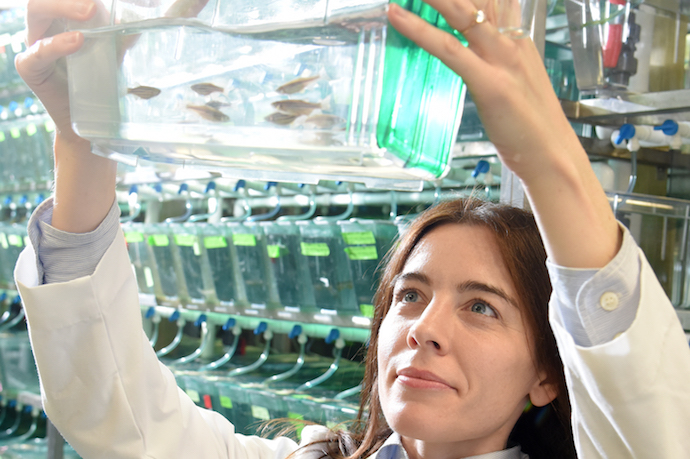Zebrafish expose tumor pathway in childhood muscle cancer

A popular aquarium fish may hold answers to how tumors form in a childhood cancer.
Muscle precursor cells called myoblasts are formed during normal fetal development and mature to become the skeletal muscles. Rarely, a genetic error occurs in which pieces of two chromosomes fuse together in a cell, triggering those cells to multiply and behave abnormally. A particularly aggressive form of the muscle cancer rhabdomyosarcoma results.
The fused genes create an abnormal protein called PAX3-FOXO1, which blocks the normal maturation of muscle cells by inappropriately turning hundreds if not thousands of genes on and off. The exact mechanism by which PAX3-FOXO1 does this is not known.
Cancer researchers at UT Southwestern developed a zebrafish model for the childhood cancer. To do this, Dr. James Amatruda’s lab inserted the human PAX3-FOXO1 gene into the DNA of zebrafish. Using this new transgenic zebrafish, the researchers showed that the fused-gene DNA causes rhabdomyosarcoma that is similar to the human disease. They found it does this by turning on another gene, HES3, which leads to overproduction of the skeletal muscle precursor cells and allows for PAX3-FOXO1+ cells to survive during development instead of dying.
“There is a lot of interest in understanding the PAX3-FOXO1 block and in identifying treatments that overcome this block,” said Dr. Amatruda, an Associate Professor of Pediatrics, Internal Medicine, and Molecular Biology and member of the Harold C. Simmons Comprehensive Cancer Center. “Such treatments could potentially cause the tumor to ‘mature’ and slow its growth without exposing the patient’s normal tissue to the side effects of chemotherapy and radiation.”
Efforts to directly counter the effects of PAX3-FOXO1 have been unsuccessful, so the HES3 gene provides a potential back door for targeted treatment of this cancer.
Current treatments for rhabdomyosarcoma include surgery, chemotherapy, and radiation. Finding a drug that specifically targets part of the pathway initiated by the PAX3-FOXO1 gene fusion could improve survival rates as well as make treatments more tolerable for young patients.
The zebrafish model of rhabdomyosarcoma the researchers developed is particularly useful because few other options are available. “Gene fusions that function as transcription factors are notoriously difficult to model in animals, hence the limited availability of vertebrate animal models for this disease. Zebrafish are powerful models because their use provides insight into how cancer genes function during development and the fish are a platform for drug discovery efforts,” said Dr. Genevieve Kendall, postdoctoral researcher and first author on the study.
The long-term goal of the work is to identify potential drugs for the most aggressive type of rhabdomyosarcoma and to test these treatments in the zebrafish model. The findings open the possibility of identifying drugs that block HES3 or its downstream targets as a cancer therapy.
The research appears in the journal eLife.
Funding for this research comes from the Cancer Prevention and Research Institute of Texas, La Ligue National Contre le Cancer, a Young Investigator grant from Alex’s Lemonade Stand Foundation, a Hartwell Foundation Postdoctoral Fellowship, a QuadW Foundation-AACR Fellowship for Clinical/Translational Sarcoma Research, the Institut Curie, and Curing Kids Cancer.
Dr. Amatruda holds the Nearburg Family Professorship in Pediatric Oncology Research and is a Horchow Family Scholar in Pediatrics.

